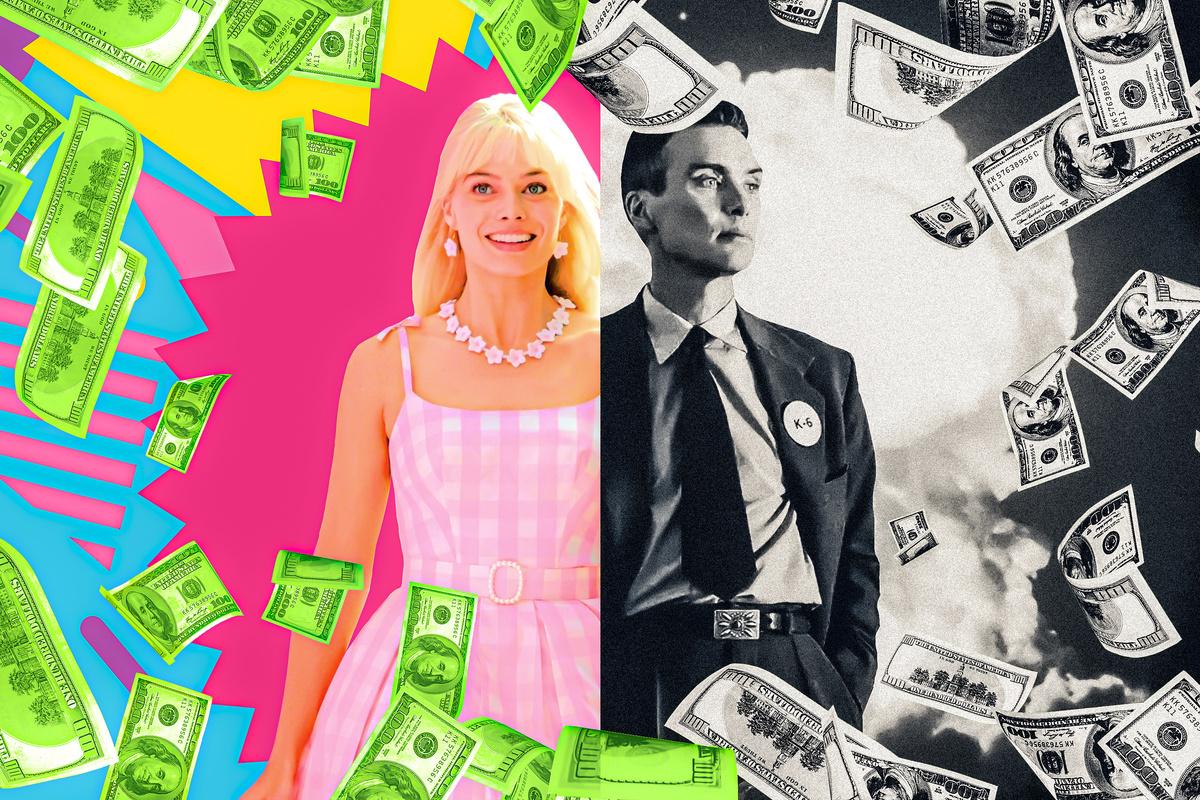
Up until last weekend, most of this year’s headlines about the box office blared bad or so-so news. Ticket sales were up compared to 2022, but not by enough to raise hopes that moviegoing would bounce back to pre-pandemic levels. And as summer blockbuster season started, 2023’s tentpoles slipped behind last year’s pace. One after another, high-profile films fell short of their predecessors’ performances. Fast X. The Flash. Transformers: Rise of the Beasts. Elemental. Indiana Jones and the Dial of Destiny. Even Tom Cruise couldn’t quite pull a Top Gun and save cinema again. The only means of escape from the “summer of flops” was seemingly to make an animated masterpiece (Across the Spider-Verse) or be embraced by QAnon conspiracists (Sound of Freedom).
Then came Barbenheimer. For a few days, at least, Barbie and Oppenheimer’s double-barreled debut has brought back movies and the monoculture—and both would-be blockbusters made bank, handily beating their box office projections. In the fourth-largest North American movie weekend ever—unadjusted for inflation—Barbie earned $162 million, lapping the $82.4 million amassed by Oppenheimer (which had a lower budget than Barbie, along with fewer screens to play on, an R rating, and a much longer running time). Each sum blew away forecasts: Estimates had ranged from $90 million to $125 million for Barbie, and $40 million to $50 million for Oppenheimer. Together, the movies made almost as much domestically as they’d been projected to make globally, and their $537 million combined worldwide haul more than doubled their projected total. In a number of ways, it was a record-breaking opening, marking the first time that one new movie grossed more than $100 million in a three-day weekend while another new movie topped $50 million. One glorious weekend was enough to spawn new headlines about cinema’s resurgence.
It also spawned efforts to explain the secret to the duo’s drawing power. Perhaps the success of the latest films from Greta Gerwig and Christopher Nolan signals that, as NPR suggested, audiences are “sick of trekking to the theater for those tired sequels, but they’ll show up … for fresh characters and original story lines.” Maybe—but is Barbie, based on a 64-year-old doll, a “fresh character”? Is Mario, who fronted 2023’s highest-grossing movie 42 years after his first appearance in a video game? Why have audiences trekked to the theater to see some sequels this year—not just Across the Spider-Verse, but also Creed III, Scream VI, and John Wick: Chapter 4, each of which did franchise-record figures? Maybe it’s more that both Barbie and Oppenheimer are good, as evidenced by their directors’ résumés, their “A” CinemaScores, and their 90-plus-percent Rotten Tomatoes ratings.
Or maybe it’s attributable to the Barbenheimer phenomenon: the reflected glow each one gained from its proximity to the other. In a sense, that’s the scariest answer, both because the conditions that created Barbenheimer probably aren’t really replicable and because the industry could convince itself that they are. Even if Barbie and Oppenheimer aren’t sequels, there’s nothing Hollywood loves more than trying to run back a big hit. And which solution sounds easier: crafting unique, compelling stories featuring fresh characters, or moving release dates around?
Some studios didn’t even wait for Barbenheimer’s breakthrough to take the copycat approach. Last week, Lionsgate shifted the release of Saw X from its original October 27 release date to September 29, when Paramount Pictures’ PAW Patrol: The Mighty Movie will also premiere. On Barbenheimer Eve, Lionsgate tweeted, “reporting for SAW Patrol, sir,” while Paramount tweeted, “Seven tickets to Saw Patrol, please,” with a #SawPatrol hashtag. A horror film and an animated kids movie make even odder bedfellows than Barbie and Oppenheimer. In a world where studios have broken the seal on “Saw Patrol”—even if in jest—could they contemplate turning Napoleon and Wonka into Wonkoleon? Anyone up for a six-plus-hour Killers of the Flower Dune dramatic double feature? Is someone cooking up a campaign to pair The Color Purple with Ferrari, both slated for Christmas Day debuts?
Before executives start rearranging release schedules, they’ll have to assess how much the Barbenheimer convergence mattered. The consensus among several box office experts I surveyed is that it mattered a great deal, though no one will commit to a hard-and-fast figure. Josh Lynn, president of box office forecasting company Piedmont Media Research, says, “I think the Barbenheimer phenomena genuinely did help in a major way to boost both films’ box office takes. … For both films to come in at about double the projections tells you that something else was happening outside the traditional modeling—and I think it’s pretty clear the convo about, ‘Which will you do? Why not do both?!’ that really started to take shape a month or so before was a huge factor in this.”
In late June, before the SAG-AFTRA strike put a stop to stars’ promotion, Cruise plugged Barbenheimer by tweeting photos of himself holding tickets to the two movies while standing in front of their respective posters. The next night, the Barbie movie account tweeted photos of Gerwig and Barbie star Margot Robbie doing the same. In July, Oppenheimer star Cillian Murphy expressed his own intention to see Barbie. All of this mutual box office back-scratching helped build buzz. Ben Carlson, SVP and general manager of media and entertainment at MarketCast, says, “The Barbenheimer phenomenon definitely drove box office.” Although he can’t put a precise dollar figure on the effect, he adds that because of the simultaneous release, “Awareness for both films was sky high. They were always going to be big, but we saw both films driving huge social conversation in large part because of each other.”
During the week of June 26, Carlson reports, Oppenheimer was mentioned more than 400,000 times on Twitter—and more than 80 percent of those mentions also referenced Barbie. (Barbie had a bigger social presence, so a lower percentage of its mentions also referenced Oppenheimer.) Oppenheimer’s percentage declined as the premieres approached and “more specific film conversation took place,” but by then a lot of the groundwork for a viral event had been laid. “Because the movies did not have naturally overlapping audiences, all of this conversation helped create awareness with non-core audiences and led to the release weekend being circled on the calendar as a major theatrical event,” Carlson says. “All of this prerelease interest and conversation led to the release date transcending a ‘movie release’ and becoming a true cultural phenomenon. … The instantly meme-able combination of pink vs. black and white became a reason to make plans with friends.”
Ray Subers, SVP of theatrical strategy at market research company National Research Group, agrees with Lynn and Carlson, saying, “While it runs contrary to conventional box office wisdom, this weekend was absolutely a ‘1+1=3’ situation where the Barbenheimer phenomenon unquestionably benefited both Barbie and Oppenheimer.” Some of that benefit came from double-feature sales: A few days before the duel debut, AMC revealed that 40,000 members (and counting) of its loyalty program had bought advance tickets to the double bill; two days later, the National Association of Theater Owners projected that more than 200,000 moviegoers would attend same-day viewings over the weekend, along with “millions of worldwide moviegoers” who would see the two movies on different days. “The head-to-head entered the zeitgeist in a way that drove excitement and urgency around getting out to the movies,” Subers says. “It was quite clear that if you didn’t make it to the movies in some way this weekend, you were going to be missing out.”
In these conversations, various comps came up, based on subject matter and/or target audience. For Barbie: Wonder Woman, Aladdin, The Little Mermaid, Minions: The Rise of Gru, and Frozen II. For Oppenheimer: Inception, Dunkirk, and Bohemian Rhapsody. Opening-weekend receipts for the first group ranged from $90 million to $130 million; for the second group, roughly $50 million to $63 million. Those figures aren’t too far off from the pre-release estimates of where Barbie and Oppenheimer would wind up. It’s tempting, if not conclusive, to chalk up most of the difference between the projections and results to the Barbenheimer boost. Another form that boost took: According to one study, Oppenheimer may have made $5 million more than it otherwise would have just because some people resorted to seeing their second choice among new movies after discovering that Barbie was sold out.
So yes, there was likely a sizable Barbenheimer halo effect, which means that there’s incentive for studios to try to recreate it if they can. Of course, Warner Bros. and Universal didn’t synchronize the releases of Barbie and Oppenheimer because they sensed some potential for synergy; the timing was either spiteful or coincidental, depending on the source. Puck reported in June that Warner “scheduled [Barbie] opposite the Nolan film on July 21 as a middle-finger to Universal after it stole Nolan during the HBO Max day-and-date debacle.” Other outlets indicate that Universal was forced to release Oppenheimer when it did because Nolan’s contract called for a summer release with a three-week exclusivity period on Universal’s schedule. Whatever the real reason(s), the positive byproducts seem to have been a happy accident for all involved.
There’s plenty of precedent from earlier eras for double features, which were developed by desperate theater owners during the Great Depression. Now, as theaters struggle to convince viewers accustomed to streaming to leave their living rooms, double features may start to seem like good gimmicks again. But there are fewer major movies released today than there were pre-pandemic, which makes it easier for each film to carve out its own space on the calendar. In addition, says Jeff Bock, senior box office analyst at Exhibitor Relations Co., “In this day and age, blockbusters primarily rely on PLF [premium large format] screens, which usually are monopolized by one new film per weekend.” That might make some time shares less lucrative.
Thus, Subers says, “My suspicion is that the release date calculus is not going to change meaningfully. This was a truly once-in-a-generation moment that I believe should be viewed as the exception to the rule. Chasing this specific head-to-head phenomenon is treacherous, and nine in 10 times it’s going to make more sense to find a lane where a tentpole can really be the movie everyone is buzzing about.”
Bruce Nash, founder and publisher of movie industry data provider The Numbers, believes Barbenheimer was “a combination of several factors that just happened to come together: moviegoers are looking for something new after relentless superhero movies; people want to get back to ‘normal’ after the pandemic; our social media feeds are so full of junk that people were enthusiastic about sharing something fun and frivolous for a change; the two movies actually dovetail in interesting ways that fostered a lot of creativity; Greta Gerwig and Christopher Nolan are both very good filmmakers, and their films could withstand some gentle mocking; and probably five other things.”
One reason this counterprogramming proved to be complementary programming is the giant gender gap in interest in the two films. “This doesn’t happen often, but usually when it does one of the films appeals more to women and the other more to men,” Bock says. “This is what happened here, but to an extreme level.”
The table below shows Piedmont’s Consumer Engagement scores—an indexed metric where 100 is average and a higher number indicates a greater built-in affinity for a film—for Barbie and Oppenheimer prior to their premieres, broken down by age group. Overall, the two films garnered very similar, well-above-average scores, which helped fuel Barbenheimer mania: This wasn’t, say, July 2008’s The Dark Knight and Mamma Mia!, where one movie’s earnings potential more drastically outstripped the other’s. Almost across the board, though, Barbie scored significantly better than Oppenheimer with women, and Oppenheimer scored significantly better than Barbie with men.
Consumer Engagement Scores for ‘Barbie’ and ‘Oppenheimer’
Those differing preferences were reflected in the makeup of the movie’s audiences last weekend, though not quite as much as they might have been had it not been for Barbenheimer increasing everyone’s interest. Barbie’s audiences were 65 percent female—helping propel it to the most lucrative opening ever for a movie directed by a woman—while Oppenheimer’s audiences were 62 percent male. That split reflected the fact that tonally, Lynn says, the movies “seemed like complete polar opposites, making it a pretty funny juxtaposition.” The ridiculousness of the team-up made it much more memeable.
Crucially, so did the fact that making a sensation out of studios crossing the streams was a bottom-up initiative, not a transparently manipulative marketing move. As Lynn puts it, “the whole idea of Barbenheimer was a really organic-feeling phenomenon. … I think if studios try this again, it likely won’t feel organic and will feel like a bad retread.” Subers says much the same: “Moviegoers are savvy and can sniff out when something feels manufactured rather than authentic. The next Barbenheimer or Gentleminions will be organic and grassroots, and likely unexpected to a degree.”
Put all of those ingredients together with Barbie’s pricey, well-executed marketing campaign, and a similar box office stew, Nash says, is “not going to happen again for another decade or two. However, I do think studios might be a little less afraid of putting big films up against each other if they are complementary, and I’ll be interested to see if anyone dares to team up to market films jointly.”
Lynn doesn’t foresee that happening, even out of mutual self-preservation. “Studios, I think, have a hard time banding together to try to do anything, let alone promote movies that aren’t specifically one of their own. … Even to try to generate a part deux of Barbenheimer for Wonkoleon … I can’t imagine studios’ marketing departments working together to really try to make that a thing.”
Maybe that’s for the best. This way, we can remember Barbenheimer fondly, as a strange, serendipitous, semi-pure (in a corporate kind of way) occurrence instead of as a concept run into the ground by an assembly line of sequels that follows in the footsteps of Transformers, Fast & Furious, or Saw. “Moviegoing is a social experience, one that you share with family and friends,” Subers says. “This was a moment to be part of, together.”
In an industry where, traditionally, nobody knows anything, you’ll never go broke betting on someone throwing up their hands and opting to call the same play that worked well at least once before. (See Mattel’s attempt to capitalize on Barbie by developing dozens more toy-based movies.) But whether or not this weekend’s windfall gives rise to disappointing sequels, we’ll always have Barbenheimer. “There has always been counterprogramming,” Carlson says. “But this was something else—a unique alchemy that made the weekend greater than the sum of its parts.”


